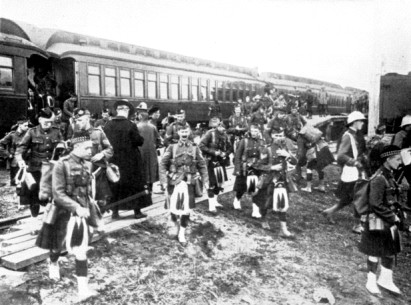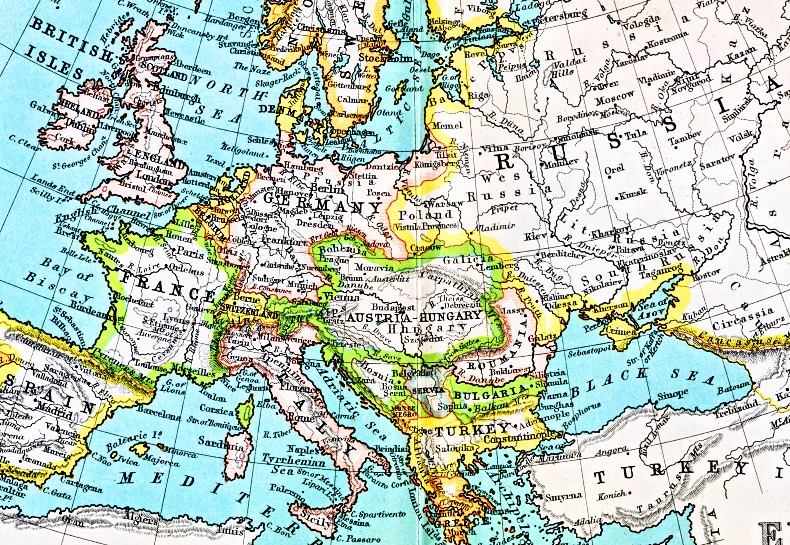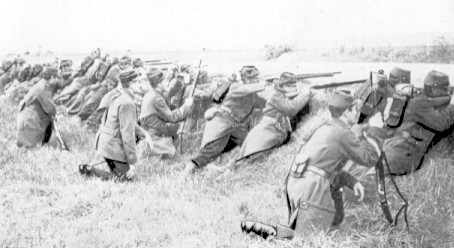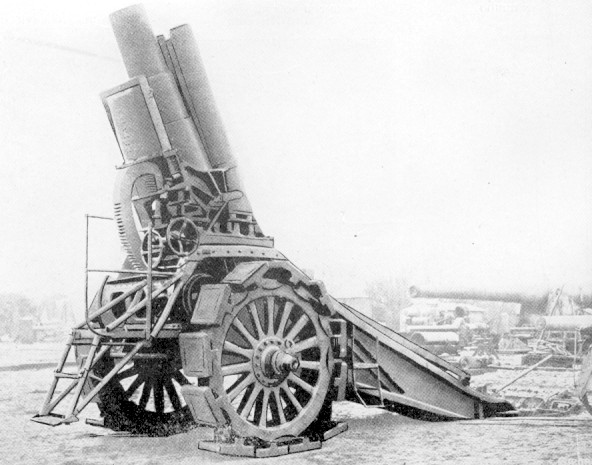World War One
Industrialized Warfare in the Great War
Firepower, technology and tactics contrasted: 1759 and 1914
This page introduces industrialized war - for which railways were essential..
Highlanders arrive at Camp Valcartier, Quebec before shipping off to World War 1.
'The Battle for a Continent'
The battle of the Plains of Abraham in 1759 is said to have determined the 'destiny
of the continent' ... between England and France.
... well, if you don't even consider many, many other factors, such as France's
sloppy and indifferent colonial administration ... and its military - which
really needed reform.
France sort of wanted a big piece of North America, but wasn't willing to work for it. On the other hand, the defricheurs and their descendants did
want 'New France' in some form, and they had put a lot of work into their
little corner of it. (One quick note: I don't insert French accent characters
just in case they decode into something confusing or really obscene within
your machine.)
Neither British Major-General Wolfe (age 32) nor French Lieutenant-General Montcalm (age
47) wanted to be in the military or serving in rustic and primitive North America anymore. They
were both burnt out and fed up.
For those who may be reading this who are not products of the traditional
Canadian educational system ... the battle of the Plains of Abraham just west of 'Quebec City' on September 13, 1759
during the Seven Years War, has been used to justify many, many things in Canadian history. This is because the
British and English-speakers simply 'won' ... and the Canadiens (habitants) supported by France, who spoke French, simply 'lost'. But history isn't simple.
Like older people remember where they were when JFK was shot ... in the
historic past, young 'traditional Canadians' since 1759 were generally
taught - formally and informally - what
they 'won' (anglophones) or 'lost' (francophones) forever at that symbolic instant in time.
... and my point would be ... the battle is well-documented, known well by Canadians,
and I just want to look at the technology of armed conflict (war) used
back then.
So forget what I just said about the politics.
European-style war
Prior to this day, Quebec had been subject to a long, effective bombardment
by British cannon and the place was wrecked. Many farms along the lower St.
Lawrence River had also been torched by Wolfe's forces. As winter was coming soon, this wasn't very sporting of them.
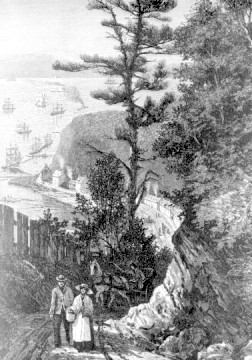
It contrasts nicely with the more modern European technology
and strategy later used in World War 1.
On their tippy-toes, Wolfe and about 4500 British soldiers 'scaled the cliffs' just up-river
from Quebec at night - technically, an amphibious landing made with the help
of the Royal Navy. Wolfe's Cove is shown here in an illustration from around 1870.
The view is looking up-river toward Montreal and the Plains of Abraham
and the settlement of Quebec are behind us in this view.
Unsure of the bigger tactical picture the next morning, Montcalm - commander of
all French troops in North America - rushed into battle with about the same number
of troops including a high proportion of Canadien militia. Montcalm
was contemptuous of 'Indian-style' fighting, and the genuine fighting skills of the Canadiens who had lived in New France for 150 years.
Wolfe's force
Picture that Wolfe stands at our left, commanding a force of Scottish Highlanders, and British
regulars - 4500 soldiers. Instead of the usual three ranks - or lines of soldiers - the troops
are shoulder-to-shoulder forming two ranks. The British force is about one
mile in width on the battlefield and their position gives them a good clear
field of fire on the battlefield. They have a few muzzle-loading cannon which
have been hauled up the cliffs. The soldiers have muzzle-loading muskets.
Muzzle-loaded weapons had the following processes and characteristics :
- Gunpowder was poured (or ladled, for cannon) into the dangerous front end (muzzle) of the weapon.
- Wadding was jammed in to push the powder back to the breech and keep it there.
- A roundish projectile was inserted and rammed home hard with a ramrod.
- The projectile moved rather loosely in the barrel, so the ramming
was done to pack things into place. The projectile was loosey-goosey because manufacturing
processes of the time couldn't make balls which would fit exactly. And if the ball was too tight, things would kind of blow up in your face. Loose was safest and best.
- With a musket, the gunpowder was set off by a spark (e.g. flint against metal) at a powder vent hole.
- With a cannon, a fire or other red-hot source was touched to a powder-primed vent hole above the powder in the barrel.
- A volley of musket fire was 'pointed' in the enemy's direction across the battlefield.
- When a cannon fired, the recoil rolled it backwards on its wheels ... so it would have to be repositioned before firing again.
Characteristics of this type of European battle :
- Slow (2 shots per minute) individual rate of fire ... because of
all that reloading, ramming and cannon repositioning activity. However, a
well-disciplined force (like the British) could keep adequate supplies of
musket balls coming from different parts of the formation on a very regular
basis. An attacking enemy was always walking into hot lead from somewhere.
- Close range between enemies on the battlefield was required
to be able to hit anything or anybody - the loose musket balls bounced around
as they raced down the gun barrel, making proper aim impossible except at close range.
- Plenty of smoke from the gunpowder - interfering with visibility
on the battlefield. Most of the combustion products of gunpowder (55%) were solids,
not gases. Naturally this also fouled the gun barrels.
- Everyone stayed in tight formation to be effective ... thoughtfully making a dense target for the enemy in the process.
- However, if the tight formation was charged by the enemy ... disciplined soldiers
in the formation, standing side-by-side with lowered pointy bayonets would be something
pretty dangerous to run into.
- Orders from the commander were quickly communicated down the chain of command by voice, by bugle, or by drum.
- So ... the ideal European battlefield system in 1759 was professionals working together in unison like a single organism.
Montcalm's force
Coming in from the right side of our
picture is Montcalm's force. They start from the walled city of Quebec
and come west through the bush to the edge of the old farm field ... where
Wolfe waits with his troops - forming that thin red line across the horizon. The
route Montcalm's troops take is strewn with trees and brush which break up
any kind of formation marching they might have done.
In hindsight ... if Montcalm had returned to the walls of Quebec, bolted the door, and just dialed 911 (i.e. the Chevalier
de Levis and his army at Montreal) France wouldn't have had to scapegoat
poor Governor Vaudreuil for 'losing the continent'. This is because it is
September, and pretty soon the British ships would have to leave for New England or get frozen
in at Quebec ... with most of the British force dying - one way or the other.
But nooooo ...
The Battle begins ...
British on the left, French coming in from the right
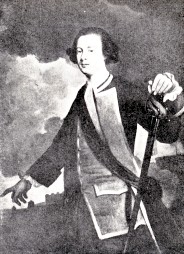
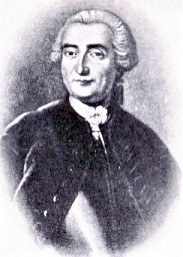
So it's about 0930hr and some French soldiers with a large number of Canadien militia come on to the field of battle - about 4500 in all.
To play head games, the British fire their cannon at the French for about
30 minutes as the latter get organized. This produces more stress than casualties.
Around 1000hr, in a ragged formation, the French come forward. The Canadien militia was not into this European 'one fighting organism' thing - any sensible person would take cover !
Then the French fire while their muskets are pretty much out of range.
French soldier thinks : We fired our muskets and nothing happened !
British soldier thinks : That wasn't so bad. These guys are bush league !
When the French come into range, the British first fire in a disciplined manner by platoons.
The French fire here and there ... 'Who's in charge ? ... What's the plan ?'
Then, in unison, the one-mile-wide red-uniformed organism fires one mighty volley at a range
of about 40 yards. To increase their firepower, two balls have been loaded
into each musket to create lots of damage and general dismay.
For a veteran British soldier, there will be severe punishment if he does
not comply exactly with the commands he has drilled with thousands of times
before. He likely fears his officers more than the enemy.
For a Canadien militiaman receiving this volley, looking forward
: his central and peripheral vision sees nothing but red coats, muzzle flashes
and smoke. Then a mile-wide swarm of angry deadly bees comes at him alone - he is not psychologically protected within a tight formation and he has never had this experience before.
The French waver and, individually and collectively, decide to retreat to
our picture's right : back toward the safety of Quebec's walls - where Montcalm
should have kept them.
Now ... performing one of the traditional duties of the cavalry ... we have
the Highlanders (sorry, the British didn't bring any horses up the cliffs).
With very large, sharp swords drawn, they run after, and work to cut down,
members of the retreating French force. In a disciplined manner, the rest
of the British force follows.
The 'foot cavalry', moving after the retreating French, is stopped in its tracks as the 'smart French' - Canadiens
behind cover - and First Nations fighters, ambush the Highlanders and British
from under cover in all directions. After inflicting some damage, they melt away.
Wolfe is dead. Montcalm will die tomorrow from a wound he just received upon reaching the walls of Quebec.
And now our statistics ...
Length of musket fire exchanges
| about 15 minutes
|
Total combatants
| about 9000 : soldiers and Canadien militia
|
Total casualties
| about 1300 *
|
Range at effective engagement
| 40 yards
|
| Commanders killed | 2
|
'Continents lost'
| 1
|
* Casualties = killed + wounded = not available for duty
Europe 1900
As you would expect, there were a few developments
between that 1759 colonial
battle involving professional European soldiers ... and World War 1.
This made the latter a very
different kind of military engagement.
Big things had changed
- Conscription ('the Draft'), early 1800s - Napoleon brought back
an invention of the ancients to build massive fighting forces for his European
campaigns. The new/old idea was that the European states could now welcome all
able-bodied males to get involved in the ever popular war game. War wasn't
just a game for professional soldiers to play on a little battlefield anymore
!
- Industrial Revolution, 1750-1850 - Machines do things better
than people (... well, except when computers use certain operating systems).
Large amounts of capital were invested in industrial machines and infrastructure, which
in turn led to a concentration of workers living around factories. This led
to the necessity of urban sanitation and the concept of 'public health'
as the impoverished and sickly workers provided a wonderful medium for disease hosting and epidemics.
- Railways and the steam engine 1800-1900 - This important technology
of the Industrial Revolution provided portable power to efficiently transport
heavy loads and power factories - free from the natural limits of wind, water
or muscle power.
- Aircraft and airships, early 1900s - powered by small gasoline engines, these could
provide some transportation, but more importantly, they provided a bird's
eye view of the ground below. Previously, only the earthbound horseback cavalry had
been available to perform quick reconnaissance on enemy positions and movements
for military commanders' decisions.
- Telegraph 1840-1900 and the steamship 1850-1900 - Communication
and world travel went hand-in-hand with the expanding industrial economy
... and the existing colonies of the European empires. Modern warships could
control the sea lanes or harass enemy colonies 'on a schedule' as long as
they could be bunkered (refueled with coal) every 8 or 9 days. Orders and intelligence
could be relayed by wireless telegraph. The whole world could now participate
in a European war !
- Understanding and regulating the economy - After :
- the works
of Adam Smith (circa 1780) and David Ricardo (circa 1800) explaining some aspects of 'economics'
- the experiences
of governments legislating elements of the Industrial Revolution
- the experiences of capitalists financing, building, and operating large corporate empires ...
- ... governments and/or rulers, government bureaucracies, and industrialists ... had the new-found
ability to focus complex national economies on a single project. In other
words, they could create a 'Total War Economy'. From this came
the cheerful conclusion that even civilians working in cities away from the battleground
were legitimate targets for shells and bombs. Humans were making big progress !
Little things had changed (relatively speaking)
- Chemical industry advances 1850-1900 - Chemical, electrical or heat treating
of coal, oil, nitrogen compounds and other materials yielded new industrial chemicals which provided
more efficacious ammunition and explosives ... and handy gases such as hydrogen and
chlorine.
- Rifling, 1850s - By using new machine technology, fine spiral
grooves could be carved into the inside of gun barrels so bullets or artillery shells
would spin down the barrel and continue to spin in flight, achieving much
greater range and accuracy than musket or cannon balls.
- Smokeless powder, 1850-1900 - more power, less smoke, for firearms
due to the chemical industry's advances. Smokeless powder fired when wet
- no one would ever say 'keep your powder dry' again ! More ammunition could be carried because less
powder was needed for firing ... new all-in-one metal ammunition cartridges could be smaller and lighter.
Barrel rifling and tight physical tolerances on small arms were also possible
because the solid residue left by gunpowder was no longer a problem. This
new-found gun barrel cleanliness maintained targeting accuracy, reliability during longer battles,
and facilitated the use of automatic cartridge feeding/ejecting mechanisms.
- Breech loading weapons with magazines 1850-1900 - Modern manufacturing
techniques allowed weapons to be mass produced with much greater precision.
The rear end of a mass-produced precision-manufactured rifle cartridge, made
from thin metal, expanded momentarily on firing to ensure that all the combustion
gases were used to force the separating bullet down the barrel ... then the spent cartridge
reverted to its original dimensions so it could be removed from the firing chamber
at the breech. With a multiple-cartridge magazine connected
to a rifle, a good rifleman might be able to fire 5-10 bullets in less than
15 seconds - before 'reloading' by pulling out the old magazine and inserting
a full one. While firing this fast would not be accurate at a distance, it
would certainly be very discouraging for an enemy running up to take over
the rifleman's position. (After each shot, a British rifleman generally had
to eject the spent cartridge and insert the next from the magazine by moving
a 'bolt' back and forth in an 'L'-shaped movement. This gross movement after
each shot generally meant it was necessary to pause to re-aim for each bullet.)
- Breech-loading artillery using rifled barrels
and smokeless powder provided the ultimate in mass production of death
and destruction for the modern battlefield. Progress, progress, progress
!
- Machine guns 1884-1918 - A quantum leap - from the hand-cranked
Gatling gun of the US Civil War to the Maxim gun/machine gun - enabled a stream of bullets
to be fired with just one press of a trigger. Conserved combustion
gases ejected the spent cartridge, and loaded and fired the next one (known today as 'fully automatic fire').
Hall Table of Fame - Historical and obsolete propellants and explosives
Gunpowder
| saltpeter (potassium nitrite) 75%
carbon 15%,
sulphur 10%
| Ancient traditional explosive and propellant.
|
Guncotton 1846
| nitrocellulose
(made by acting on cotton with nitric and sulphuric acids)
| 'Smokeless', more powerful than gunpowder.
Corroded artillery barrels, unstable & caused factories to blow up (oops) until it was finally stabilized decades later.
|
Poudre B 1886
'smokeless powder'
| nitrocellulose (collodion & guncotton), ethanol, ether
| 3x more powerful than gunpowder, stable so it could be used in small arms.
Smokeless so it allowed for concealed firing positions (e.g. snipers).
|
Cordite MD
circa 1905
| guncotton 65%
nitroglycerin 30%
vaseline 5%
| Less corrosive than guncotton when used in artillery, more stable than guncotton. Shortages during part of WW 1 when acetone was in short supply.
Acetone was used to gelatinize the guncotton during manufacture.
|
Old and new compared
- The old 1759 battle model was standing shoulder to shoulder on a little old European battlefield.
-
Beyond 40 yards (or metres), you wouldn't really hope to hurt anybody.
-
A soldier's firing rate was two rounds per minute.
-
Cannon had to be repositioned and re-aimed after each firing.
- With the new 1914 battle model, heavy rifles could provide harassing fire up to one mile
away, and fire about 20 rounds per minute with some accuracy.
-
Machine guns could sweep a wide area with about 400 rounds per minute.
-
The range of heavy artillery was measured in miles.
- Some quick-loading field guns could fire 20 rounds
per minute and the recoil disappeared into 'recoil shock absorbers' -
so the guns didn't roll out of position when they
fired.
New Idea 1: If your soldiers start walking across a flat open field toward the enemy they will be cut down at a great distance.
New Idea 2: Forget about tight formations. They just make easy targets. Let your soldiers spread out and enjoy the whole battlefield !
As you will see - unfortunately - soldiers would
find themselves ordered to walk across open fields and through battlefield
constrictions in full view of the enemy !!
With greater firepower, individual soldiers controlled more space
In 1914, the French soldiers above are using newer tactics. You can't see the enemy
because their bolt action rifles shoot much farther.
Unlike Montcalm's soldiers, they are 'tak-ing cov-er' !
They are still bunched together and you can see a couple of officers behind
them, keeping an eye on things. This doesn't look like World War 1, but it
is.
One dumb thing the French above were doing : wearing bright red trousers
with their dark blue coats. At least it looked spiffy.
You should have seen
the Zouaves !
The French army had their colours done again and got into more subdued hues pretty quickly.
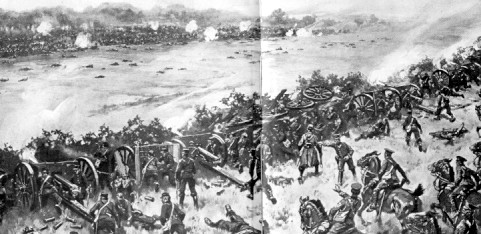
In the graphically-muddy newspaper-type illustration above, you can see a more traditional
battle early in the war.
At Cambrai, the French and British (foreground) were retreating
from Mons, Belgium ...
and had set up one of many rear-guard actions as the Germans
advanced on Paris.
From behind cover, French infantry fired rifles half-heartedly
at the advancing Germans.
As the Germans confidently approached, the hidden
field guns and machine guns opened up with devastating results at a range of 250 yards.
British cavalry (in the bottom right corner) also participated as the Germans
retreated.
The Germans' invasion strategy was to swing counter-clockwise across Belgium toward
France like a big door - Luxembourg was the 'hinge'. The man on the right side
of the swinging German 'door' was supposed to 'brush his sleeve on the English
Channel'. The Germans did not get that close to the Channel, and Dover-Calais
remained a viable route for transporting troops and supplies from Britain - along with other English Channel ports.
The British had an expeditionary
force in western Belgium. These English/German encounters in Belgium were
the last great exhibitions of the fine marksmanship and concentrated fire, of professional British soldiers,
using bolt action rifles. The tactics would be changing.
As World War 1 began, half the time the various armies were just trying to find each other in the forest, behind hills, etc.
(In contrast, on the Eastern Front - between Russia and Germany in the area of Poland -
the battles were free-ranging across open terrain for most of the
war - trench systems were seldom necessary in the east.)
This newspaper illustration shows 'guns' in action. Did you ever see the movie 'Full Metal Jacket' ? ...
'This is my rifle ... this is my gun.
This is for shootin' ... this is for fun.'
'Guns' = artillery ... which classically comes in three flavours :
Traditional 'field guns' - sort of visible above - were towed
around by horses and positioned like cannon for battle on the field. The
shells followed a relatively flat, direct trajectory.
Howitzers - Napoleon or someone was fiddling around and found
out that a shell fired at an upward angle of 45 degrees ... travels the farthest.
That's the general idea with howitzers. While the field guns above have front row
seats, World War 1 howitzer crews usually didn't have to worry about hand
grenades or machine gun or rifle bullets - because they enjoyed life far behind the lines.
Well ... except when they were subject to pre-emptive 'counter battery work'
by enemy howitzers.
Mortars - We've all seen the small ones on TV. Some bigger ones
were for throwing heavy shells from one set of trenches to the other. Why bother
with large trench mortars ? Their 'big bombs' could be fired fairly close to the
enemy BUT from under cover to an enemy under cover. The most pleasant thing about them was that their
slow incoming rounds could often be heard and avoided if a soldier was lucky.
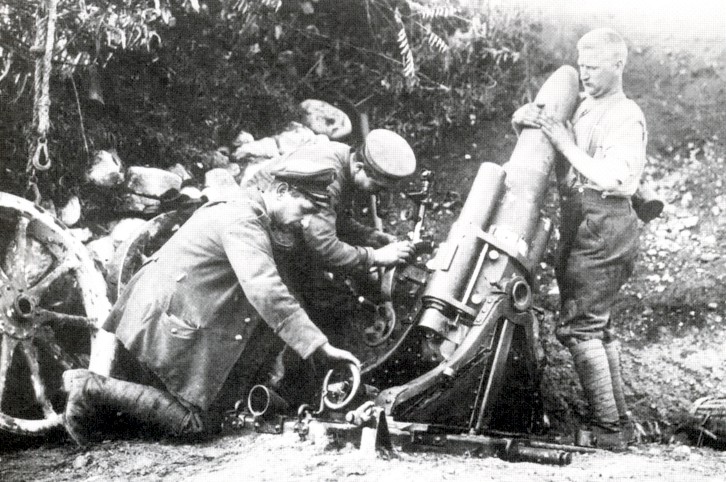 Fun with a trench mortar
Fun with a trench mortar
The Famous French 75s in the battlefield !
The thing about these 75 mm field guns at the right was they were quick firing. A crew could fire off a shell every 2-3 seconds. 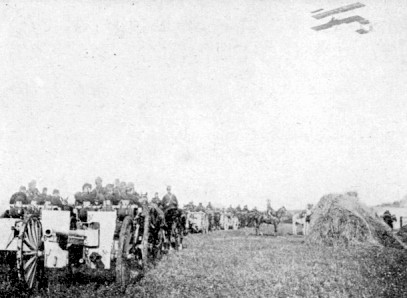
- Open the breech.
- Insert shell.
- Close breech.
- Bang !
- Open the breech, spent shell casing pops out.
- Reload.
During a field battle on level ground, a battery of 75s had amazing firepower.
Wow ... an 'aeroplane' ! This must be a cheating newspaper photographer's composite photo. Certainly,
a frail aircraft like that didn't last long during the war. Planes turned
out to be a big deal later.
But look again ...HORSIES ! Lots of them ! And the war's voracious appetite for horses never really diminished in spite of new technologies.
The 'Entente' ... Britain, France, (and sometimes Russia, USA) etc. ...
had the reserve manufacturing capacity to make greater use of motorized transportation later.
However, the 'Central Powers' ... Germany, Austria-Hungary, (and sometimes the Ottoman Empire) etc. ...
and the many smaller theatres of war always took a terrible toll on horses and other draft animals, including dogs.
Desperately chasing elusive German quasi-guerillas in east Africa, imported
horses taken into areas where the tsetse fly was endemic had a life expectancy of 4 weeks.
As I continue to build the case for more efficient transportation systems for another page, notice the big stack o' hay.
Hay, oats, etc. were transported to the battlefield in great quantities to 'fuel' the horses.
Some sources suggest the tonnage of ammunition, and the tonnage of fodder, hauled into the war zone ... were roughly equivalent.
How war technology and ideas evolved on the western front ...
As you might expect, no one really planned things the way they turned out.
In most cases, when one side used a new weapon or technique, the other side
quickly adapted ... unless their hard-headed military dogma initially slowed progress (oh hello, Britain).
Generally, the Germans had better weapons and techniques in the beginning ...
- Storm troopers were elite soldiers who were 'empowered'
to make decisions on the spot as they advanced in multiple groups of fewer than 10 soldiers.
-
Storm troopers advanced with gathering momentum toward their objectives ...
pockets of resistance were ignored - to be worn down later by regular infantry or artillery.
- The German military saw the benefits of the machine gun for their
armed forces before the war and really stocked up on them ... and they had better artillery.
Generally, the British military was focused on seapower and was not well-prepared to fight a European land war ...
- Empowering ! ... and trendy 'loose/tight' principles for soldiers
?! ... well, it just wasn't right ! 'It would be like letting the monkeys run the zoo !' (a 1983 quote)
- The British rifleman is the finest in the world ! Cavalry is what
is needed for decisive victory ! Machine guns would undermine our war-fighting
traditions and they might even be unethical.
- However, as the war stumbled along, the British military finally mastered modern technology and tactics and surpassed Germany.
-
Kitchener - the guy with a moustache pointing sternly from recruiting posters
- a career military man and Secretary of State for War ... presided over
a massive expansion of the British Army from 20 to 70 divisions (division
= about 12,000 soldiers) during the first two years of the war.
Kitchener used the idea of 'Pals Battalions' (A battalion is about 1000 soldiers
- a small, complete fighting unit). The 'pals' were a group of sportsmen,
or sometimes a group of similar occupation - most often they were from the same city
or geographical area. Local social pressure acted to influence individuals
to volunteer with their pals. On the battlefield, this resulted in the strong
cohesion and loyalty desirable in military units.
Generally, the French (and Belgians) expected the Germans to pop by every
few decades ... and had pre-invested heavily in forts and citizen soldiers
...
- Important point : they were fighting to defend their own lands and homes.
- One of the first lessons of the war was that permanent fortifications
could be bypassed, starved out, or smashed by huge German Krupp-built siege
guns.
Krupp siege mortars like the one above were used
to crack open the stone and concrete forts of France and Belgium.
This piece would probably have been
pulled into position by a steam-powered traction engine - one of those early farm tractors.
The longest barrel fired the shell. The cylinder on the right was typical
of many guns and it was designed to absorb the force of the the
recoil.
This looks like a builder's photo at the Krupp yard.
It's a small world, after all ... it's a small, small world
The large 1915 newspaper map is included below because it offers so much
easy-to-understand information about conditions early in the war. It was created before
computer graphics !
For most of the war, the 'Western Front' extended in a continuous
line of trenches : from the northern border of Switzerland, continued obliquely
(west of the France-Belgium border), then north at around Lille to the last 'k' in Dunkirk.
The Germans held, and took advantage of, most of the important mining and industrial
land of France and Belgium during the war.
If nothing else, you can conclude that this 'battle for a continent' was going
to involve more than the 9000 soldiers employed on the Plains of Abraham
!
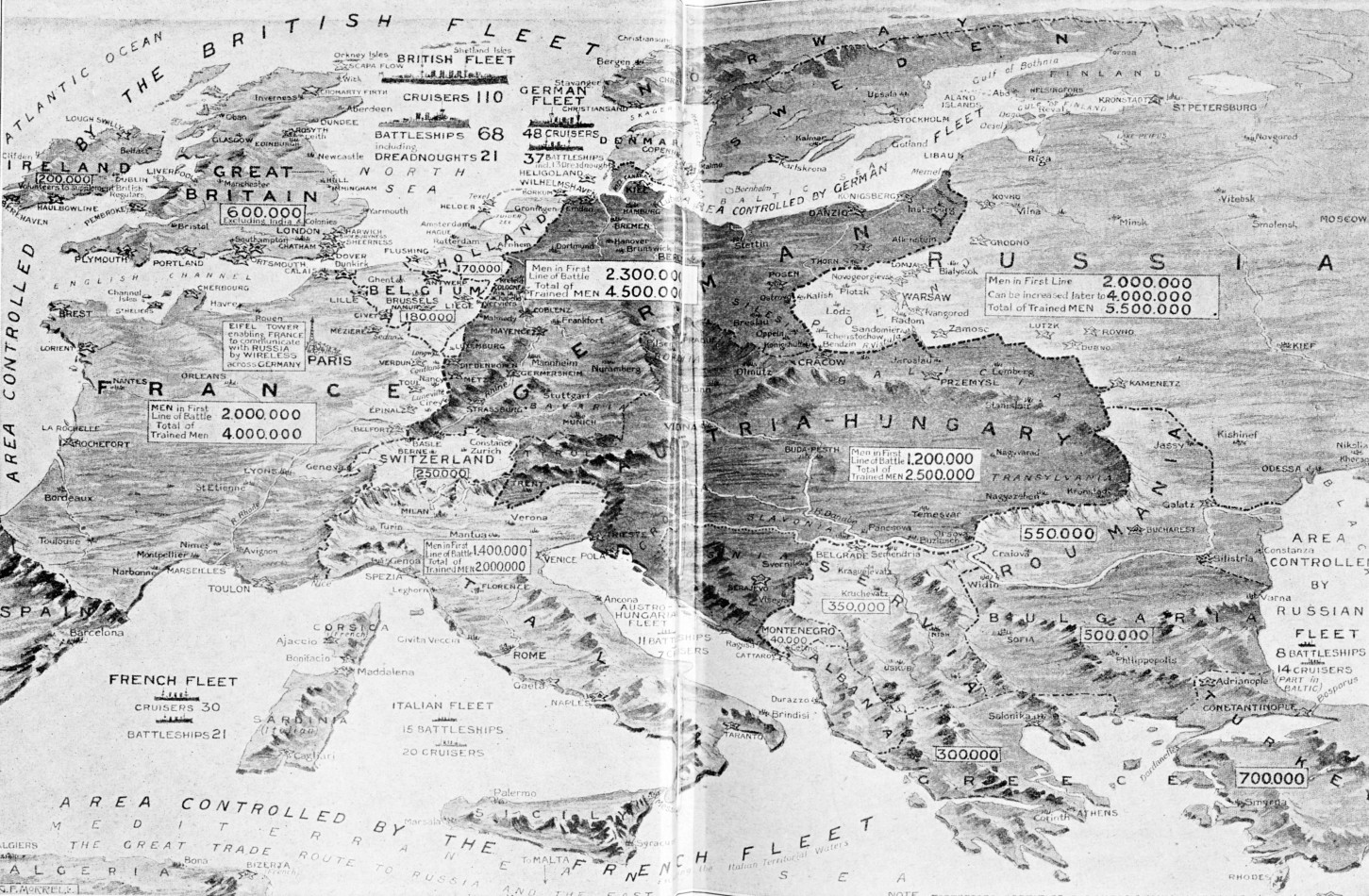
Notes:
- 'The Great trade route to Russia and the East' is written on the Mediterranean Sea ... The
British tried to seize 'the Dardanelles' (key straits in Ottoman Turkey) through Kitchener and Churchill's
diversionary Gallipoli campaign, so that Russia could be resupplied by sea.
The German navy controlled the Baltic Sea, so the only other choice was the
Mediterranean. This didn't work out as planned.
- The notation of 600,000 at Great Britain notes in small print : 'excluding India and colonies ' . World War One pulled in many colonial resources, particularly from the
empires of Britain and France. There is a fairly complete list of participants
at the end of this page. The battles and tactics I describe include the colonial
troops of the many nationalities under French and British command.
-
Soldiers had excellent firepower ... modern accurate rifles with preloaded magazines of about 5-10 rounds.
-
However, machine guns were often placed in staggered and sheltered positions to defeat the firepower of the advancing infantry.
-
The Germans made the decision to dig in using easy-to-defend trenches
so some troops could be taken away to fight the Russians on the Eastern Front.
-
Until this point in history, barbed wire had been for cattle. Barbed wire
entanglements were placed in front of the trenches to slow down attacking
enemy infantry - to help defend the trenches. Paths were left through the
barbed wire entanglements to allow for infantry attacks FROM your own trenches
TO the enemy trenches. Your defending machine gunners only had to target
these specific paths in the wire. In other words, the paths were like turnstiles used to control crowds. You set your machine guns up to target the 'turnstiles'.
- Hand grenades, grenade launching rifles, flamethrowers, and trench
mortars were used in efforts to destroy the machine gunners and other enemy troops. During a battle, one
source suggested, a working machine gunner would live for about 5 minutes.
- To break the wire for an attack, high explosive artillery shells were used ... sometimes
successfully. Bangalore torpedoes (long pipes filled with explosives) could
sometimes be slid along the ground under the wire and detonated to clear
a path for the infantry.
- Generally ... all routine activity ... troop rotations, barbed wire placement in No Man's Land, and trench raids
were conducted at night. It was too dangerous to be sighted by the enemy
by daylight. The daytime was for sleeping.
- Learned the hard way : There was really no way for infantry to successfully
attack a trench protected by machine guns with barbed wire entanglements
in front.
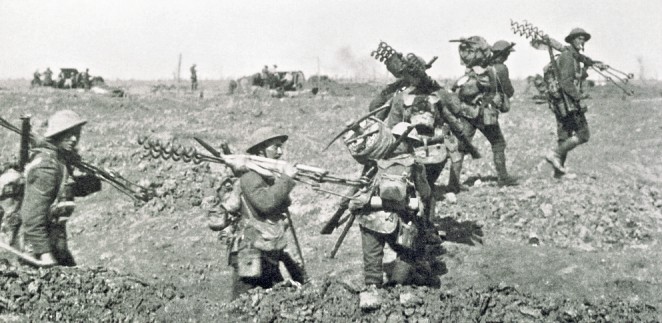
This photograph is taken well behind the front lines because :
- The soldiers are walking above ground level.
- They are going to do some wiring in daylight.
- Artillery is working in the background at the left.
Besides their rifles, packs, picks, shovels, coils of wire, etc. the soldiers are carrying an invention that saved many lives. Most activity - particularly placing barbed wire in No Man's Land - was
done at night to avoid becoming a target. However, noise could invite enemy
parachute flares which would turn night into day for those found in No Man's
Land. The curly-bottomed fenceposts could be silently turned into the ground
by inserting a bar through the 'eye' on top - thus avoiding the noise of trying
to drive them in with mallets ... and a sniper's bullet.
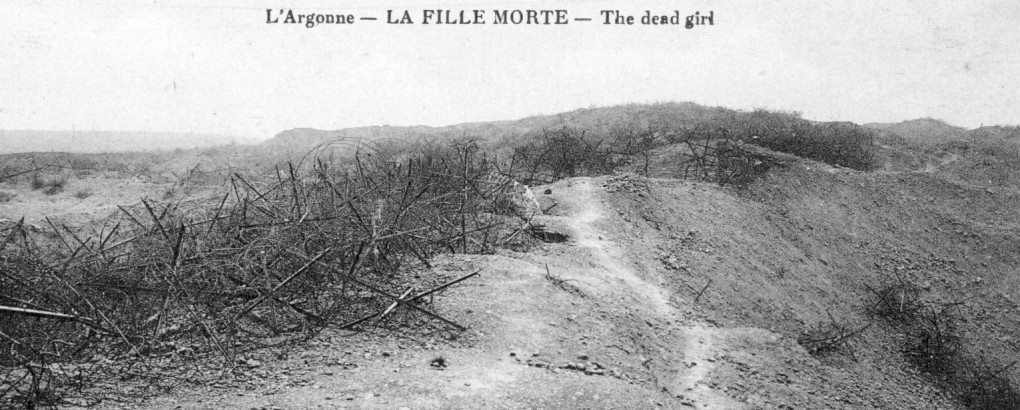 This postcard photograph was most likely taken after the war. I have
been unable to find any wartime story to explain the site's name.
This postcard photograph was most likely taken after the war. I have
been unable to find any wartime story to explain the site's name.
It shows the accumulations of barbed wire entanglements and the destruction of soil and vegetation.
The Argonne Forest was in the French/American sector, about 120 miles east of Paris.
-
Artillery usually had to be 'registered' in new locations by observers ... The gunners were often
too far away to see their targets or to assess their fire.
- Paraphrasing the observers (a lot) ... 'a little to the left' - kaboom ... 'now up a bit' - kaboom ...'Perfect ! fire for effect' - lots of kabooms.
-
Artillery observation was done from hills, trees, and eventually tethered observation
balloons filled with hydrogen above friendly territory.
-
Then enemy aircraft started coming over to shoot down the observation balloons in flames.
-
Then observers started wearing parachutes in case they had to leave before their shift was over.
-
Then friendly planes, shot down the enemy planes, which were shooting down the observers.
- Then enemy planes, shot down the friendly planes, which were shooting
down the enemy planes, which were shooting down the observers.
-
Finally, specialized observation aircraft and fighter aircraft began their own separate 'war' above the battlefield.
-
Sometimes, if things were quiet, fighter aircraft would bomb or strafe enemy ground positions.
- London and Paris got their first bombing by large German biplane bombers in 1917 ... Total War ... included civilians far behind the lines.
- The Secretary of State for Air in Britain sent a message to the
Chief of Air Staff 'I would very much like it ... if you could start
up a big fire in one of the German towns. If I were you, I would not be too
exacting as regards accuracy in bombing railway stations in the middle of
towns. '
- 'Tactical' (military target) bombing had evolved into 'Strategic'
(city) bombing before the end of World War 1 - the grandfather of 'Mutually
Assured Destruction' 50 years later.
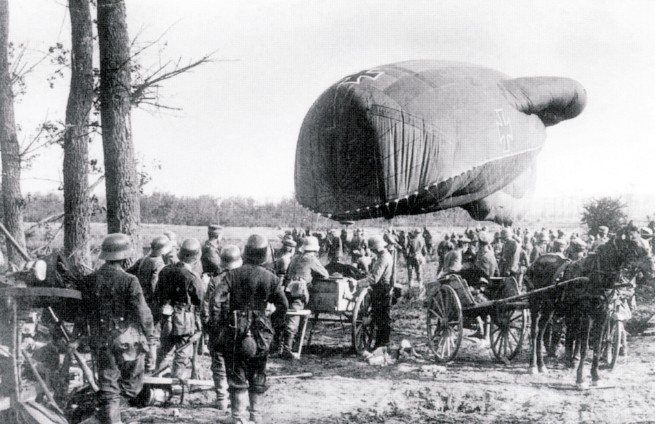
Everyone and his horse is out to watch the launch of a tethered German observation balloon.
Once aloft, an observer connected via a telephone wire to the ground could
see 60 miles under good conditions and correct the aim of artillery.
More than just tasteful decoration, the Maltese crosses are designed to help prevent 'friendly fire' from German aircraft.
('Fun' fact : The Germans' unique Pariskanone rail-mounted gun sent shells to an altitude of 130,000 feet
- requiring the Earth's rotation and curvature to be factored in to the targeting calculations.
By the end of the war, a range of 100 miles was possible with this type of gun.)
Things get really fancy ...
Observers in aircraft kept track of all changes on the enemy side, taking aerial photographs for commanders to review. Weather permitting!
The arrangement of things starting from No Man's Land on the British side :
- Barbed wire entanglements
- Front line trenches
- Often second and third line combat trenches - in case the first line
was taken ... with numerous connections between them. The trenches were often named in alphabetical order.
- Then, extensive honeycombs of 'communications trenches' for moving
and massing of troops, communications, and storing food and ammunition supplies.
In theory you could walk from Switzerland to the North Sea without
ever leaving this elaborate maze of ... um ... ditches.
- Then, heavy
artillery batteries, some organized medical treatment, heavy transportation
systems and supply massing areas. ('Bricks and mortar' hospitals were often
near the coast.) 'Rest' billets for soldiers taking a duty turn away from
the trenches were often within range of lucky strikes by heavy artillery
shells.
- Command and administrative support were in the rear and safe. Thank goodness.
- Orders and information were communicated by pigeons, dogs, human runners, telegraph and telephone.
If the enemy shelled, the telegraph and telephone lines were destroyed. Pigeons didn't
like to fly in damp overcast weather.
- Sometimes the British would shell for days before an attack. Continuous rapid
shell explosions were termed 'drumfire' and sometimes their frequency could
be approximated by chattering one's teeth. This means ... sometimes over a million of artillery shells were fired in a few days.
-
With great physical and psychological hardship the Germans (for example)
survived in reinforced concrete bunkers which might be 3 stories into the
ground. They lived this way under bombardment for days at a time, completely
cut off from the world, including food, water and medical care. The British
were always amazed to see the Germans pop up with machine guns right after
the shelling stopped, and effectively defend against an attack. Often during
intense shelling ... the Germans had resolved that active death through bitter fighting was better than passive death by shelling. So, freed from their bunkers ... they finally had control over their fates and fought hard.
- If the British had the right shells ... High explosive was used to break
the bunkers and cut the wire. Air-burst shrapnel was used to kill troops. A variety of different gas shells would keep the enemy off balance.
- Sometimes they had the right shells, used enough of them in the right
way, and actually co-ordinated barrages with friendly troop advances on the enemy..
- But often, up to 1/3 of the shells were duds early in the war, and high explosive
shells went deep into the mud and did nothing except chew up the land the
infantry had to cross.
- As you can imagine, there are many practices
I am leaving out for ... brevity. The Germans got really elaborate with 'defense
in depth' rather than just a few frontline trenches holding 'all their eggs in one basket'.
A Map from the 1920s - mostly of the British sector during the war.
-
Varying only 20 to 40 miles (maximum) in position from east to west, the pink dashed
lines show the positions of fixed trench lines ... as well as their dates of use.
-
The orange area, including West Flanders is western Belgium.
-
The pink area is France and you can see Dunkirk on the coast of the North Sea.
-
West 20 miles from Dunkirk is Calais (off the map). From there it is only 22 miles to Dover.
-
The yellow dashed line shows the maximum extent of Germany's quick but objectiveless offensive in the spring of 1918.
- Railways : black/white alternating ... double track.
- A single black line is a secondary railway line ... or a river.
- Canals are black lines with hatching on one side.
-
A reference suggested that great battles were fought at Ypres (Belgium)
because German occupation of the nearby coastline could affect British dominance
of the North Sea/English Channel waterway. The British were concerned about
U-boat torpedoes, naval shelling, and particularly mining of the transportation
routes from England to the war zone. A mine had sunk Kitchener's warship,
killing Kitchener and almost all the crew while he was on his way to Russia
in 1916.
- Finding the correct pronunciation of 'Ypres' counter-intuitive ... (pronounced: EEpr) ... the British generally referred to it as 'Wipers'.
-
In Flanders, the Germans had long held the heights overlooking the artillery-churned
soupy mud occupied by the British. Having no British divisions handy to take
Passchendaele (150 feet above sea level) and feeling the need
for a battle, Field Marshal Sir Douglas Haig, commander of the British Expeditionary
Force sent in ANZAC (Australia & New Zealand Army Corps) forces. They
ran into machine gun fire from all sides, were unable to get through the
wire, and withdrew. Canadian commander General Sir Arthur Currie was then
called on to send in the Canadian Corps and he did so under protest. There
were 16,000 Canadians killed and wounded during the Passchendaele Battle
(or Third Battle of Ypres) in exchange for 5 square kilometres of mud
and 3 Victoria Crosses.
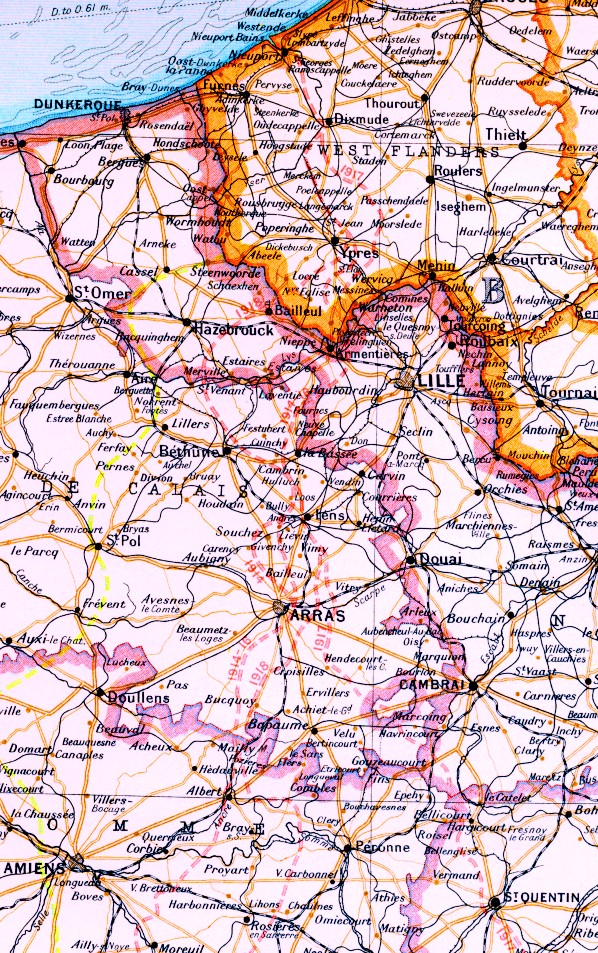
Geography, soil science, and 'public health' on the Western Front
Before :
- Much of the Western Front battlefield had been farmland, scattered with woodlands and villages.
- Natural drainage patterns had formed over centuries.
- Farmers worked their fields by plowing furrows, and also deeper rigoles from time to time, to retain or drain moisture as needed.
- The woodlands also helped modify drainage patterns and reduce erosion.
- In Flanders (particularly that area of Belgium near the English Channel) the water table was often near the surface.
- Livestock manure was used to maintain the fertility of the soil.
After :
- High explosive shells disrupted the natural drainage patterns, and shellholes quickly filled with rainwater.
- The incessant shelling also destroyed all trees and vegetation on the battlefield.
- After an attack, it was usually impossible to evacuate the wounded from No Man's Land by day.
- Freshly created war graves were opened by new shelling and unburied dead humans and animals were scattered by the shelling.
- Trenches = ditches and they often filled with water because
natural drainage patterns no longer existed. In some essential cases 'breastworks'
(above-ground trenches : mud forts) were built at key points because of the high water
table.
- The soil of this former farmland had already been well treated with decomposing livestock manure.
- Penicillin had not been invented.
- Advancing soldiers were under orders not to stop to attend to the
wounded. Advancing soldiers took cover in water-filled shellholes as needed.
- Surgical intervention was generally far to the rear, inaccessible during a battle, and therefore hours away and sometimes days away.
- ... So bacterial infections were a bit of a problem ...
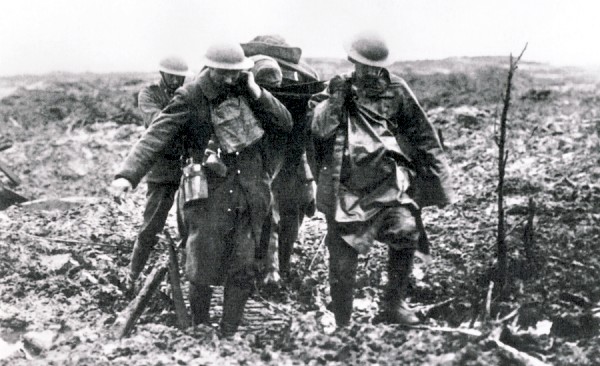
How to be a winner !
British Strategy, version 1.0 ... Breakthrough !
- Achieve a breakthrough in the enemy lines and use the cavalry to decisively
exploit the weakness behind the enemy - in other words, 'fight the last war'.
-
To avoid the deadly fire of enemy artillery and machine guns on both flanks, the breakthrough must be several miles wide.
- On to Germany before Christmas !
British Strategy, version 2.0 ... Attrition
-
Germany is literally being starved for food and war materiel by the Royal Navy North Sea blockade.
-
Austria-Hungary and the Ottoman Empire are not competent allies of Germany.
-
Germany is alone against Britain and France - and the Entente has access to American financing and war materiel. American companies are making good money for their efforts.
-
Use heavy shelling and repeated massed attacks. Kill more enemy soldiers than you lose.
-
Eventually surviving Entente soldiers will outnumber surviving German soldiers in a 2 to 1 ratio.
- The Entente will have won !
British Strategy, version 3.0 ...
Let's see ... Breakthrough? nope ... Attrition? nope ...
'The Tanks are coming, the Yanks are coming !'
- Gasoline powered tanks, conceived separately by both the French
and British around 1915, carry heavy machine guns or light field guns ... and
lead infantry over barbed wire and across enemy trenches. The Germans
are completely surprised and have nothing similar. Tanks break down in battle and becoming sitting ducks ...
the crews decide to use up their ammunition while they are sitting there ... and terrified Germans still run up
to them to surrender !
- The German army is fighting alone without decent allies, worn
down ... and the civilian population is literally starving and demoralized.
During the war, the mail censors keep their fingers on the psychological
pulse of the armies and report to their superiors on soldiers' morale and
gripes. It turns out that the British and French soldiers have had a bellyful
of war and just want it to end. The French soldiers mutiny (really a very
disciplined sit-down strike) and get a commander sacked and demand that they
be treated better than beasts being sent to the slaughterhouse. About fifty
are executed with full division march-pasts by the bodies - as an example
of what better treatment looks like. 'You don't let the monkeys run the zoo.'
- This is a strategy ?
- The Americans have joined the war really late in April
1917. The recent German promise of unrestricted U-boat warfare against neutrals
was one thing ... but the last straw was being shown secret British
decodes of German diplomatic feelers to Mexico about an alliance and an attack
on U.S. soil ... if the U.S. were to enter the war. 'Fresh man in the mow !'
as we used to rejoice on the farm. Certainly as smart as any British Commander
at the beginning of the war, U.S. Commander General Pershing doesn't know
what his troops are in for. He still thinks riflemen and mobility will win
the day - i.e. 'fighting the last wars' ... in his specific case ... against
Geronimo, and most recently 'Pancho' Villa in Mexico (prototype for The Frito
Bandito). The Americans save shipping space by using French Renault tanks
and French equipment and British helmets. They want to fight as an independent
army. The US Army in Europe would have reached critical mass by 1919, so
their chief impact is psychological on both sides.
- ... Say,
did I ever tell you about 'Fresh man in the mow !' ?
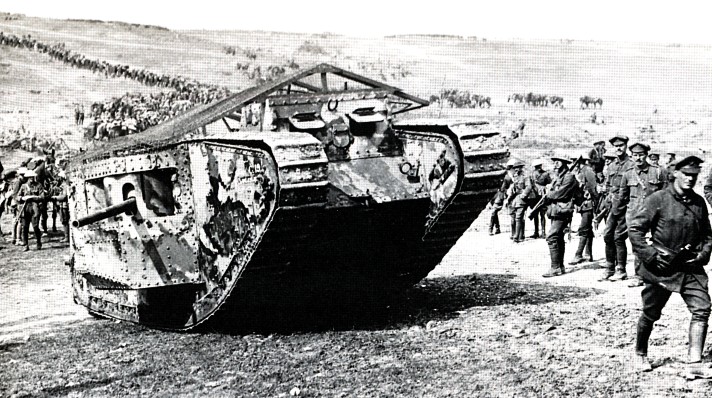
The British tank above is not that impressive, is it ?
If you were a German machine gunner, you could stay
behind cover and barbed wire and disable all the soldiers to the right of
the tank almost immediately. Unlike the dead soldiers, the tank would continue
to grind and screech toward you at 2-3 miles per hour ... over the barbed
wire ... over the trenches ... until the heavy gun in the side turret was
pointed directly at you.
All tanks break down a lot, but the first ones set world records for breakdowns and getting stuck in the mud. They were hellish
to work in (noise & heat), and exploded into flame, burning the crew to death, when the gasoline
tank was hit. (In World War 2, Germans referred to some British gasoline-fueled tanks as 'Tommy Cookers'.)
But early tankers learned quickly ... Already, you can see a design 'upgrade'
to prevent grenades and bombs from disabling the tank from above ... that
little peaked roof made of fencing. Tossed grenades would bounce off and
a larger bomb could not be placed directly on the steel roof - so its blast
would be diffused.
The End
Everything seemed to fall apart at once. Workers, other civilians, and low-ranking soldiers
everywhere were fed up.
The Czar had previously been tossed out in Russia.
The Kaiser - the emperor of Germany - could be next.
For at least the last couple of war years, Germany had actually been run by a military dictatorship.
There could have been a Russian-style 'socialist revolution' in Germany.
Instead, there was a German 'revolution at the top' and Kaiser Bill got out of the way.
President Wilson's Fourteen Points were accepted by a new German chancellor and the fighting stopped.
No one had really won decisively on the battlefield. The German soldiers
marched home as if a victory had been won.
A few years later, to get German citizens in the right
frame of mind for World War 2, they were told that the faithful, long-suffering
World War 1 soldiers (among them, a cheerless Corporal Adolf Hitler) had
been stabbed in the back by German politicians.
The following statistics demonstrate the relative industrial capacity of the Entente / US ... (the 'Allied Powers') :
British tanks produced by war's end (crew: usually 8)
| 2500
|
French tanks produced 1918 (crew: usually 2 .. up to 8)
| 5000
|
German tanks produced by war's end (big: crew of 18)
| about 20
|
British, French, U.S. aircraft production 1918
| 11,200
|
German aircraft production 1918
| 2,000
|
'War cannot be won. No one can win a war.'
Central Powers : Military deaths / Military wounded
Austria-Hungary *
| 1,100,000
| 3,620,000
|
Bulgaria
| 87,500
| 152,390
|
Germany *
| 2,036,897
| 4,247,143
|
Ottoman Empire *
| 800,000
| 400,000
|
* Empire broken up as a result of the war.
European countries of Entente/Allied Powers : Military deaths / Military wounded
Belgium
| 38,172
| 44,686
|
France
| 1,397,800
| 4,266,000
|
Greece
| 26,000
| 21,000
|
Italy
| 651,010
| 953,886
|
Montenegro
| 3,000
| 10,000
|
Portugal
| 7,222
| 13,751
|
Romania
| 250,000
| 120,000
|
Russia *
| 1,811,000
| 4,950,000
|
Serbia
| 275,000
| 133,148
|
England, Scotland, Ireland, Wales
| 885,138
| 1,663,435
|
* Empire broken up as a result of the war.
Non-European countries of Entente/Allied Powers : Military deaths / Military wounded
Australia
| 61,928
| 152,171
|
Canada
| 64,944
| 149,732
|
India
| 74,187
| 69,214
|
Japan
| 415
| 907
|
New Zealand
| 18,050
| 41,317
|
Newfoundland
| 1,204
| 2,314
|
South Africa
| 9,463
| 12,029
|
United States
| 116,708
| 205,690
|
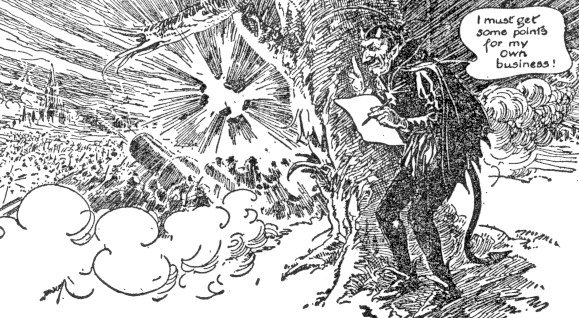
In the left background, a village and church are being shelled.
In 1915 when this cartoon was published in the U.S., the worst was yet to come.
Back to sitemap